APPENDIX F
The
Business Cycle --
Social, Health, and Welfare Consequences
This Appendix displays
important links and connections between structural changes in:
- The money stock
- Bank-money (specifically,
commercial real estate loans)
- The number of units foreclosed.
- The number of therapeutic abortions.
- The number of suicides (total male and female).
- The separation rates (alive
or dead) for heart disease:
- myocardial infarctions
or heart attacks (male and female), and
- ischemic heart disease
(male and female).
The Charts demonstrate
that the time-distribution and time-structure patterns of money
propagate way beyond the marketplace -- with serious social, health, and welfare
implications. Two conclusions are unavoidable:
- The origin of much social
and welfare misery is economic.
- To
decrease misery and health care costs, overinvestments by speculators and usurers
will have to be curbed.
|
|
The
Business Cycle1
Did
Increases in the Number of Therapeutic Abortions Have an Economic Origin?
Links to Increases in the Money Stock |
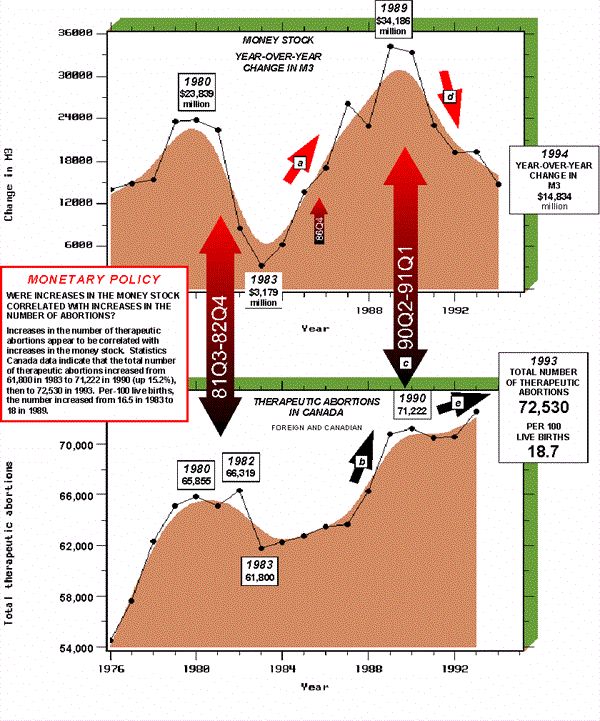 |
Chart F-1
Did Increases
in the Number of Therapeutic Abortions Have an Economic Origin? Links to Increases in the
Money StockThe Chart demonstrates clearly that
economic policies can have serious adverse effects. Increases in the number of abortions
appear to have had economic origins -- these have been much too large to be
attributed to chance.
Sources: Statistics
Canada, Canadian Economic Observer, Historical Statistical Supplement, 1994/95,
Catalogue 11-210, July 1995 (Bank of Canada: monetary aggregates -- M1, M2, and M3); and
J. Hagey, C. Nair, and S. Wadhera, Therapeutic Abortions 1993, Statistics Canada,
Health Statistics Division, Catalogue 82-219, July 1995 (total therapeutic abortions and
abortion rates).
[Copyright © 1998 by
MACROKNOW INC. All rights reserved.]
|
|
The
Business Cycle2
Did
Increases in the Number of Therapeutic Abortions Have an Economic Origin?
Links to Increases in Commercial Real Estate Loans. |
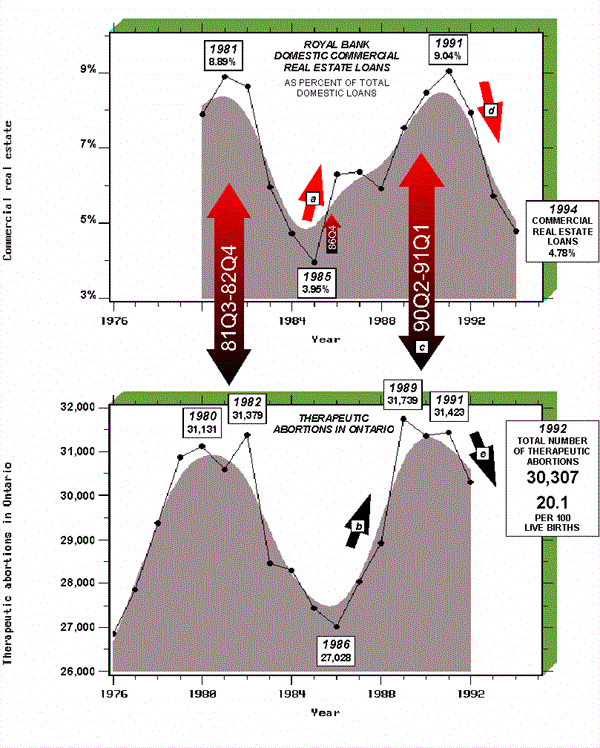 |
Chart F-2
Did Increases in
the Number of Therapeutic Abortions Have an Economic Origin? Links to Increases in
Commercial Real Estate LoansThe number of total therapeutic
abortions in Ontario increased from 27,028 in 1986 to 31,739 in 1989 (17.4%)! The
increases in the number of abortions around recessionary periods have been much too
large to be attributed to chance.
Sources: Royal Bank
annual reports (loans by industry, as at September 30); and J. Hagey, C. Nair, and S.
Wadhera, Therapeutic Abortions 1993, Statistics Canada, Health Statistics Division,
Catalogue No. 82-219, July 1995 (total therapeutic abortions and abortion rates).
[Copyright © 1998 by
MACROKNOW INC. All rights reserved.]
|
|
The
Business Cycle3
The
Number of Units Foreclosed (CMHC) and the Number of Suicides, Compared |
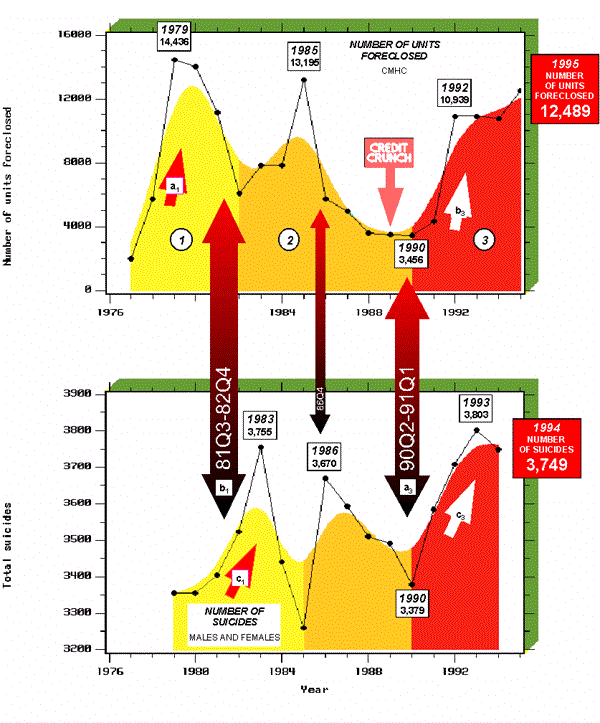
| IS PROPERTY SACRED?
In The Gospel of Wealth and
Other Timely Essays (New York,
1900), the American industrialist Andrew Carnegie asserted: "upon the sacredness of
property civilization itself depends . . ." Therefore, the right of the lender to his
money (and Carnegie's "legal right of the millionaire to his millions") should
be the same as the legal right of the home-owning borrower to his property. Since property
is sacred, it should be interesting to inquire if
increases in the number of foreclosures (losses of property) were correlated with
increases in the number of suicides (losses of life). |
|
Chart F-3
The Number of
Units Foreclosed (CMHC) and the Number of Suicides, ComparedThree periods, each marked by a
decrease in the GDP (1981Q3-1982Q4, 1986Q4, and 1990Q2-1991Q1), are delineated. Note the
three steps in the pattern for the first two periods: increase in the number of
foreclosures (arrow a1), recession (arrow b1), increase in the number of suicides
(arrow c1). Note the change in the pattern
after 1989 (the onset of the "credit crunch").
Sources: Andrew
Carnegie, The Gospel of Wealth and Other Timely Essays (New York 1900), 1962, at
18; S. Julien, CMHC, private communication, July 3, 1996 (number of units foreclosed);
Statistics Canada, 18 publications providing vital or mortality statistics for the
identified periods: Catalogue 84-206 (1976-1986), Catalogues 82-003S and 82-003S12
(1987-1990), and Catalogues 84-209 and 84-209-XPB (1991-1994).
[Copyright © 1998 by
MACROKNOW INC. All rights reserved.]
|
|
The
Business Cycle4
Did
Increases in the Hospital Discharge Rate
for "Heart Attacks" for Males Have an Economic Origin? |
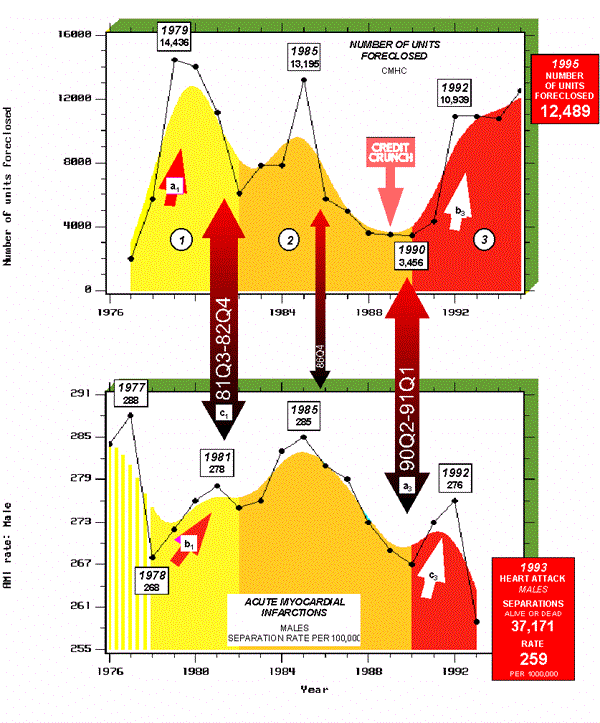
HEART
ATTACKS
DID INCREASES IN THE NUMBER OF HEART ATTACKS
HAVE AN ECONOMIC ORIGIN?
The 1990Q2-1991Q1 recession was followed by considerable misery for many in Canada. During
1991-1992:
- The number of foreclosures (CMHC)
increased by 7,483.
- The total number of "heart
attack" separations (hospital discharges for acute myocardial infarctions -- alive or
dead) increased by 3,478 (males: 2,269; females: 1,209).
The increases in
the hospital discharge rate for "heart attacks" around recessionary periods are
simply too large to be attributed to chance. |
|
Chart F-4
Did Increases
in the Hospital Discharge Rate for "Heart Attacks" for Males in Canada Have an
Economic Origin?Three periods, each marked by a
decrease in the GDP (1981Q3-1982Q4, 1986Q4, and 1990Q2-1991Q1), are delineated. Note that
the GDP also decreased in 1974Q3-1975Q2 and in 1979 Nov.-1980Q2.
Sources: S. Julien,
CMHC, private communication, July 3, 1996 (number of units foreclosed); Statistics Canada,
13 publications providing hospital morbidity statistics for the identified periods:
Catalogue 82-206 (1976-1985), Catalogue 82-003S (1985-1988), Catalogue 82-003S1
(1988-1990), Catalogue 82-216 (1990-1993), and Catalogue 82-216-XPB (1993-1994).
[Copyright © 1998 by
MACROKNOW INC. All rights reserved.]
|
|
The
Business Cycle5
Did
Increases in the Hospital Discharge Rate
for "Heart Attacks" for Females Have an Economic Origin? |
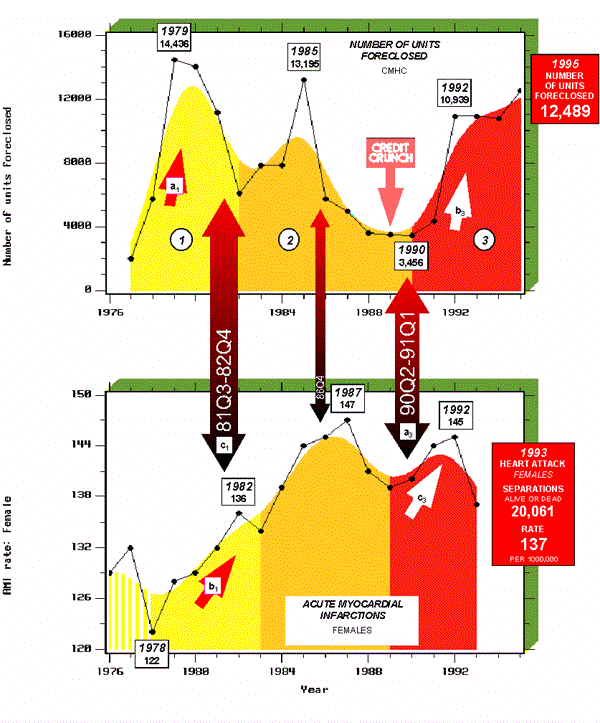 |
Chart F-5
Did Increases
in the Hospital Discharge Rate for "Heart Attacks" for Females in Canada Have an
Economic Origin?Three periods, each marked by a
decrease in the GDP (1981Q3-1982Q4, 1986Q4, and 1990Q2-1991Q1), are delineated. Note that
the GDP also decreased in 1974Q3-1975Q2 and in 1979 Nov.-1980Q2.
Sources: S. Julien,
CMHC, private communication, July 3, 1996 (number of units foreclosed); Statistics Canada,
13 publications providing hospital morbidity statistics for the identified periods:
Catalogue 82-206 (1976-1985), Catalogue 82-003S (1985-1988), Catalogue 82-003S1
(1988-1990), Catalogue 82-216 (1990-1993), and Catalogue 82-216-XPB (1993-1994).
[Copyright © 1998 by
MACROKNOW INC. All rights reserved.]
|
|
The
Business Cycle6
Did
Increases in the Hospital Discharge Rate
for Ischemic Heart Disease for Males Have an Economic Origin? |
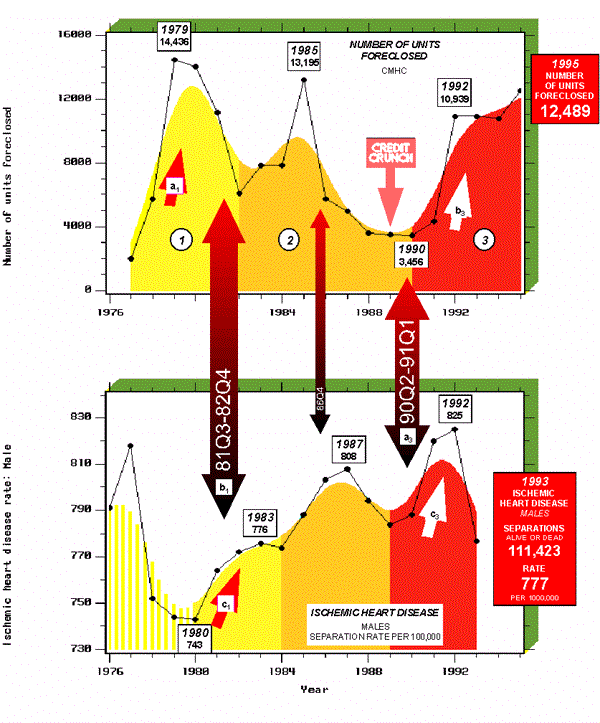
ISCHEMIC
HEART DISEASE
The 1990Q2-1991Q1 recession was
followed by considerable misery for many in Canada. During 1991-1992:
- The number of foreclosures (CMHC)
increased by 7,483.
- The total number of ischemic heart
disease separations (hospital discharges -- alive or dead) increased by 13,200 (males:
8,210; and females: 4,990).
The origin of much misery is economic. To
decrease misery, and health care costs, overinvestments by speculators will have to be
curbed. |
|
Chart F-6
Did Increases
in the Hospital Discharge Rate for Ischemic Heart Disease for Males in Canada Have an
Economic Origin?Three periods, each marked by a
decrease in the GDP (1981Q3-1982Q4, 1986Q4, and 1990Q2-1991Q1), are delineated. Note that
the GDP also decreased in 1974Q3-1975Q2 and in 1979 Nov.-1980Q2.
Sources: S. Julien,
CMHC, private communication, July 3, 1996 (number of units foreclosed); Statistics Canada,
13 publications providing hospital morbidity statistics for the identified periods:
Catalogue 82-206 (1976-1985), Catalogue 82-003S (1985-1988), Catalogue 82-003S1
(1988-1990), Catalogue 82-216 (1990-1993), and Catalogue 82-216-XPB (1993-1994).
[Copyright © 1998 by
MACROKNOW INC. All rights reserved.]
|
|
The
Business Cycle7
Did
Increases in the Hospital Discharge Rate
for Ischemic Heart Disease for Females Have an Economic Origin? |
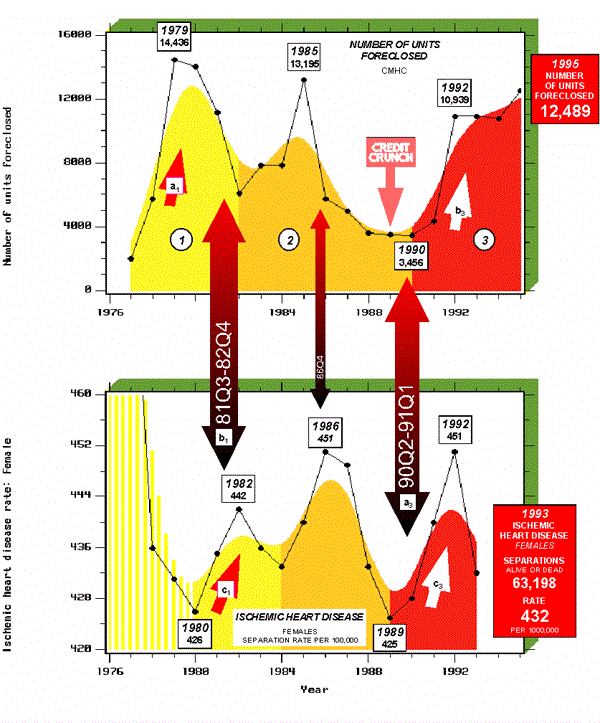 |
Chart F-7
Did Increases
in the Hospital Discharge Rate for Ischemic Heart Disease for Females in Canada Have an
Economic Origin?Three periods, each marked by a
decrease in the GDP (1981Q3-1982Q4, 1986Q4, and 1990Q2-1991Q1), are delineated. Note that
the GDP also decreased in 1974Q3-1975Q2 and in 1979 Nov.-1980Q2.
Sources: S. Julien,
CMHC, private communication, July 3, 1996 (number of units foreclosed); Statistics Canada,
13 publications providing hospital morbidity statistics for the identified periods:
Catalogue 82-206 (1976-1985), Catalogue 82-003S (1985-1988), Catalogue 82-003S1
(1988-1990), Catalogue 82-216 (1990-1993), and Catalogue 82-216-XPB (1993-1994).
[Copyright © 1998 by
MACROKNOW INC. All rights reserved.]
|
|

|






